fluffy bunny
Harmless

Posts: 25
Registered: 17-10-2002
Location: Australia
Member Is Offline
Mood: No Mood
|
|
Resorcinol synthesis
I'm trying to find a method for synthesising resorcinol, for producing styphnic acid (trinitroresorcinol), and lead styphnate.
I've only found a breif description in my chemistry dictionary, that it can be made by reaction of benzenedisulphonic acid with sodium hydroxide.
However, i was thinking that another possible route could be as follows:
Nitration of benzene to 1,3 dinitrobenzene. Followed by reduction to 1,3 diaminobenzene. Then diazotization, and hydrolysis, to 1,3 dihydroxybenzene
(resorcinol).
Now thats alot of work for resorcinol, but its all fun!
What do u think? Is it feasable?
Im just not sure that the diazotization would work on both amine groups?
And im a bit worried about working with dinitrobenzene due to its toxicity.
Does anybody know of any other methods?
Thankyou for any help.
|
|
|
blindreeper
Unregistered
Posts: N/A
Registered: N/A
Member Is Offline
|
|
Well instead of making it...
If you email me I have a good supplier that sells to individuals. But unless you really want to make it...
There shippings is dirt cheap, 2.5L of 70% HNO3 was $15 for shipping 
Edit: Sorry I just looked at your profile and your da man form e&w you gave me the supplier lol
[Edited on 10-3-2003 by blindreeper]
|
|
|
Blind Angel
National Hazard
   
Posts: 845
Registered: 24-11-2002
Location: Québec
Member Is Offline
Mood: Meh!
|
|
Maybe you already saw it but powerlabs has a way to synthetise it:
http://www.powerlabs.org/chemlabs/styphnic.htm
/}/_//|//) /-\\/|//¬/=/_
My PGP Key Fingerprint: D4EA A609 55E4 7ADD 8529 359D D6E2 33F6 4C76 78ED |
|
|
blindreeper
Unregistered
Posts: N/A
Registered: N/A
Member Is Offline
|
|
Err..
He is trying to make RESORCINOL not SYTPHNIC ACID. Sorry but didn't you read the post?
|
|
|
Blind Angel
National Hazard
   
Posts: 845
Registered: 24-11-2002
Location: Québec
Member Is Offline
Mood: Meh!
|
|
Oups, sorry i misreaded, but he want to make resorcinol for making styphnic acid... anyway sorry
/}/_//|//) /-\\/|//¬/=/_
My PGP Key Fingerprint: D4EA A609 55E4 7ADD 8529 359D D6E2 33F6 4C76 78ED |
|
|
BASF
Hazard to Others
  
Posts: 282
Registered: 5-11-2002
Member Is Offline
Mood: hydrophilic
|
|
Quite an interesting task....
from a hobby-chemists point of view:
1)Direct nucleophilic substitution on an aromatic ring affords violent reaction conditions:
benzene-1,3-disulfonate + NaOH (350°C, molten NaOH)>benzene-1,3-diphenoxide (HCl)>recorcin(1,3-dihydroxybenzene)
and even more if u take a less good leaving group, like Cl-
2)Cumene-hydroperoxide-process:
benzene + propene(H+, heat)>
cumene(1-methylethylbenzene)(O2 from air + initiator, maybe an organic peroxide)
>cumenehydroperoxide(1-methyl-1-phenylethylhydroperoxide)(10%H2SO4,heat)>
phenol + acetone
This is a bit off-topic since i don´t believe it would be possible to make a dihydroxy-arene with this method, i know....
3)fluffy bunny´s method:
Not a bad idea....but it has 4 steps, so the yield will probably be shit.
A good point of the synthesis is that it can all be made with easily available substances, and the reduction of the nitro-groups can be done with
Fe/HCl instead of Ni/H2 or Pt/H2.
HLR
|
|
|
Magpie
lab constructor
    
Posts: 5939
Registered: 1-11-2003
Location: USA
Member Is Offline
Mood: Chemistry: the subtle science.
|
|
Does anyone happen to know the partition coefficient for resorcinol between ether and water?
The single most important condition for a successful synthesis is good mixing - Nicodem
|
|
|
smuv
National Hazard
   
Posts: 842
Registered: 2-5-2007
Member Is Offline
Mood: Jingoistic
|
|
octanol/water is: 0.79-0.93 according to http://www.inchem.org/documents/icsc/icsc/eics1033.htm. Resorcinol would be expected to have an even greater partition coefficient for
ether/water. Not the best partition coefficient, but three or four extractions with a reasonable amount of ether should get almost all of it. You
even add salt to the solution, but I think this is overkill.
I want to warn you, ether is way more soluble in acidic solutions than neutral or basic ones. I assume you are doing an extraction from a fairly
acidic solution. I strongly recommend you adjust the pH of the solution to only be just slightly acidic; you will end up using less ether and getting
a more efficient extraction.
|
|
|
Magpie
lab constructor
    
Posts: 5939
Registered: 1-11-2003
Location: USA
Member Is Offline
Mood: Chemistry: the subtle science.
|
|
Wasn't that log[Kow]? If so, then K = 6.3 for log=0.8, which would be quite good. See
http://www.inchem.org/documents/cicads/cicads/cicad71.htm
I also found some reference that indicated K=4, which would also be sufficient, as 2 extractions with an equal weight of ether would recover about 96%
of the resorcinol if I've done my math right.
I also found a patent where they used 2 equal volumes of ether, but did not report the % recovered.
My water solution pH = 3 per procedure. I've reduced its volume to ~100 mL, which caused a great deal of NaCl to ppt out. So I'm saturated in salt
right now.
Thanks for the tips.
[Edited on 16-2-2011 by Magpie]
The single most important condition for a successful synthesis is good mixing - Nicodem
|
|
|
Magpie
lab constructor
    
Posts: 5939
Registered: 1-11-2003
Location: USA
Member Is Offline
Mood: Chemistry: the subtle science.
|
|
I was all prepared to extract my resorcinol from the aqueous solution today. My plan was to use a 0.5M FeCl3 solution to test the water for evidence
of residual resorcinol following each extraction with ether, per procedure. Following make-up of the FeCl3 solution I tested my product and much to
my surprise and dismay, the test was negative. I verified the test with some phenol which gave a strong violet.
So I'm aborting/suspending the synthesis for now. I'll save my product for awhile in case any of you have some suggestions.
The following is a write-up of the procedure I followed up to this point:
The substrate for this synthesis was the 13.1g of disodium m-benzenedisulfonate that I made using technical benzene and homemade SO3. This synthesis
is reported elsewhere on this forum. Unfortunately I had no readily available method for verifying the purity of the disulfonate. But I also had no
reason to suspect its quality.
My resorcinol prep was based on the findings of Phillips and Gibbs in "Fusion of Sodium Benzene-m-disulfonate with Sodium Hydroxide for the Production
of Resorcinol," in the Journal of Industrial and Engineering Chemistry, vol 12, p 857-860, Sept 1920. That is, the disulfonate was fused with
anhydrous NaOH at 310C for 2 hours (I used 1.5hrs) using a mole ratio of NaOH/disulfonate of 16:1. A 3.5" Lodge cast iron frying pan was used for the
fusion, as shown below.
The NaOH was first melted with a bunsen burner in the iron pan then the disulfonate flakes were added slowly, with some foaming & fizzing. The
melt was kept stirred with a glass stirring rod. Periodic checks of the temperature with a TC indicated the melt was 300-330C. It tended to solidify
if any cooler.
Upon cooling the melt solidified hard in the pan, defying my attempts to dig it out. I then submerged it in hot water, thereby being able to break it
up and dissolve it. After filtering to remove some iron hydroxide and carbon, I ended up with 750mL of aqueous caustic product. I then boiled this
down to 150mL.
Con HCl was then added with stirring to bring the pH down as my procedure in Fierz-DAvid & Blangey's 1949 "Fundamentals of Dye Processes," p. 144,
called for Congo Red indication of distinctly acid, which I took as pH 3. At about pH 7 I could distinctly smell phenol. There was a lot of fizzing
which I took as SO2 evolution (I didn't smell any as the hood fan was ON.) There was quite a little brown residue (1-2g) so I removed this by
filtration.
This was then further reduced in volume to ~100 mL. During this reduction a great deal of NaCl precipitated out which I again removed by filtration.
(See final picture.) I now judged this product ready for ether extraction. However, when I couldn't get a positive FeCl3 test I aborted/suspended
the synthesis.
If you have any comments, questions, or suggestion please let me know.
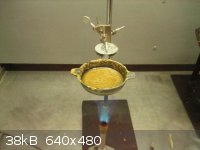 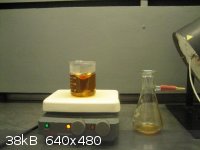 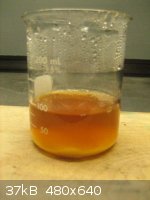 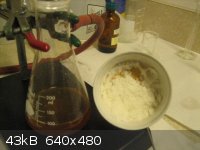
The single most important condition for a successful synthesis is good mixing - Nicodem
|
|
|
smuv
National Hazard
   
Posts: 842
Registered: 2-5-2007
Member Is Offline
Mood: Jingoistic
|
|
Too bad. I don't see anything wrong with your workup.
If SO2 was released (which I guess you cannot confirm for sure because of the hood) then it is very likely a phenol formed. I am guessing that you
produced predominantly/exclusively the monosulfonate and when you concentrated the reaction mix you ended up losing all the phenol you made to steam
distillation. Why you did not get resorcinol I cannot be sure, but when it comes to problems like this, it is important to isolate variables. You
need to confirm for sure, that you have what you think you have; that your disulfonate was reasonably pure. The best way to do this is to make an
organic salt from it (ex with aniline) and get the melting point of that salt/compare it to literaute. A procedure to do this for sodium
tosylate/p-toluidine is given on page 140 in the book by Fieser in the forum library.
[Edited on 2-18-2011 by smuv]
|
|
|
Magpie
lab constructor
    
Posts: 5939
Registered: 1-11-2003
Location: USA
Member Is Offline
Mood: Chemistry: the subtle science.
|
|
I still don't have a conclusive explanation for my failure to make resorcinol. There was a lot of evaporation and filtering of the fusion product,
however, as you say. I will be trying this again once my quartz tube comes back from the shop and I can make more SO3.
I finally did find a melting point for the sodium m-benzenedisulfonate: 300C (Sigma-Aldrich MSDS). This is too high for my mp heat transfer fluid so
wouldn't have done me any good anyway. I'm fairly confident I had a good product at this stage. But it would be great to be able to confirm that.
The reference recently retrieved by jokull shows how the Russians made resorcinol on a very small scale with about 80% yields both for the disulfonate
and the resorcinol. I will be trying to use their techniques as much as possible next time. One major change is that I will use straight KOH instead
of NaOH. I also would like to use a molten metal bath for the fusion to avoid hot spots. As for the inert gas cover, that may be a little more of a
challenge.
The single most important condition for a successful synthesis is good mixing - Nicodem
|
|
|
Magpie
lab constructor
    
Posts: 5939
Registered: 1-11-2003
Location: USA
Member Is Offline
Mood: Chemistry: the subtle science.
|
|
Quote: Originally posted by Magpie  | | I still don't have a conclusive explanation for my failure to make resorcinol. ... I will be trying this again.... |
I did try it again:
Sulfonation to Make m-benzenedisulfonate disodium (m-disalt)
I started with 6.7g of benzene. Used a nominal 20% oleum followed by a nominal 66% oleum per Fierz-David procedure (0.075 scale). Brought
temperature up to 90C with hotplate and held at this temperature for an hour. Used Ca(OH)2 to neutralize, filtered, then added Na2CO3, and filtered
again. Evaported filtrate with steam bath then used 135C oven to finish drying the m-disalt to a solid. This is the same procedure as I used before.
Caustic Fusion to Make Resorcinol
The resulting weight of the m-disalt was 30.5g which is way above the 18.75g expected, so concluded that a lot of Na2SO4 was likely present. Will
discuss this later. A molten metal bath (Bi-Sn eutectic) and a nickel crucible were used for the caustic fusion, holding a bath temperature of 320C.
See picture of homemade assembly below. The caustic consisted of 24.5g of NaOH and 86.1g of KOH. All of the m-disalt was added to this forming a
thick melt. A lid was placed on the crucible and the melt heated for about 3 hours.
The melt was dissolved in 400mL of water and brought to pH 4 using muriatic acid. This was evaporated down to 50mL of liquid in stages, removing
gross quantities of a mixed salt (Na2SO4, NaCl, K2SO4 and KCl) at each stage. The 50 mL of salt saturated aqueous liguid was then extracted twice
with 50mL of ether. The ether was then distilled off leaving about 0.5g of resinous liquid.
To confirm that I had at least made some resorcinol I proposed to use the resinous liquid to make fluorescein dye. The dye indeed was made and is
shown in the two test tubes on the right. The first is the "as made" and is acid. The last was made alkaline.
The other test tubes show the following 0.5M FeCl3 test results (left to right):
1. Violet color with phenol.
2. Pale violet with dilute brine from above synthesis.
3. Rose color with the concentrated brine from above synthesis.
4. Test of the brine following ether extractions.
Discussion
I feel that I have to correct two problems before I can get a proper yield of resorcinol: 1) I have to find a method to accurately make 20% and 66%
oleum from the raw oleum I make with my tube furnace. This must include a method for accurate assay. Not knowing just how much oleum I added is the
reason I think I had so much Na2SO4 going along for the ride with my m-disalt, and 2) I have to find a way to confirm the identity and assay of the
m-disalt intermediate.
Comments, questions, and suggestions are welcomed.
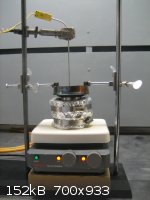
[Edited on 13-4-2011 by Magpie]
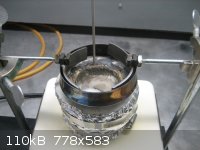
[Edited on 13-4-2011 by Magpie]
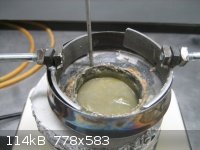 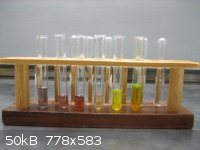
The single most important condition for a successful synthesis is good mixing - Nicodem
|
|
|
smuv
National Hazard
   
Posts: 842
Registered: 2-5-2007
Member Is Offline
Mood: Jingoistic
|
|
Are you dead set on making it through this route? Maybe a method like m-dinitrobenene to m-phenylenediamine to resorcinol would be more convenient?
"Titanium tetrachloride…You sly temptress." --Walter Bishop
|
|
|
Magpie
lab constructor
    
Posts: 5939
Registered: 1-11-2003
Location: USA
Member Is Offline
Mood: Chemistry: the subtle science.
|
|
Yes, if I just wanted resorcinol I would buy it. I feel I'm very close to achieving success, if I could just solve the assay problems I identified.
Most importantly I need to learn how to assay oleum as this useful reagent will be used for other syntheses.
Also, this synthesis is so interesting that I can't let go of it. 
[Edited on 13-4-2011 by Magpie]
The single most important condition for a successful synthesis is good mixing - Nicodem
|
|
|
smuv
National Hazard
   
Posts: 842
Registered: 2-5-2007
Member Is Offline
Mood: Jingoistic
|
|
I understand. Either way, you might want to check out the link at the end (about various ways of producing resorcinol).
http://www.nmmu.ac.za/documents/theses/KhaileTJ.pdf
"Titanium tetrachloride…You sly temptress." --Walter Bishop
|
|
|
Magpie
lab constructor
    
Posts: 5939
Registered: 1-11-2003
Location: USA
Member Is Offline
Mood: Chemistry: the subtle science.
|
|
After verifying the strengths of needed oleums I have made disodium m-benzenedisulfonate at 65% yield. Purity was found to be high as determined by
NMR and IR spectroscopy. Now on to NaOH fusion for the resorcinol.
[Edited on 15-7-2011 by Magpie]
The single most important condition for a successful synthesis is good mixing - Nicodem
|
|
|
Magpie
lab constructor
    
Posts: 5939
Registered: 1-11-2003
Location: USA
Member Is Offline
Mood: Chemistry: the subtle science.
|
|
The 13.5 grams of verified disodium m-benzenedisulfonate was used to synthesize resorcinol in my 3rd attempt. The procedure of Blangey &
Fierz-David (Fundamental Processes of Dye Chemistry) was used. Having no "baking process" equipment I used an open nickel crucible as described
up-thread. Heating time was 5 hours with stirring at least once/hr. Molten metal bath temperature ranged from about 280 to 340C. A caustic mixture
of 88mole% NaOH/12mole%KOH was used, giving a mole ratio of 11:1 caustic:disulfonate
The acidified product (40mL) was extracted w/3x40mL ether. The ether was removed by distillation using a steam bath. Since the product residue was
so small (a few mL) no attempt was made to purify it by distillation. The product was poured onto watch glasses and air dried. A picture of the
products is shown below. The yellowish material is resorcinol contaminated with a tarry residue. The long clear crystals on the little watch glass
are relatively pure resorcinol I believe.
I tested both with 0.5M FeCl3, each giving a strong violet color, which is positive for resorcinol. The yield was 3.1g. Expected yield was 4.1g.
%yield was 58.9%, including impurities.
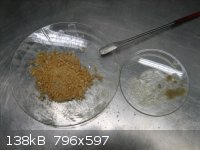
[Edited on 25-7-2011 by Magpie]
The single most important condition for a successful synthesis is good mixing - Nicodem
|
|
|
smuv
National Hazard
   
Posts: 842
Registered: 2-5-2007
Member Is Offline
Mood: Jingoistic
|
|
Good work! Any Idea why the first two attempts didn't work out?
"Titanium tetrachloride…You sly temptress." --Walter Bishop
|
|
|
Magpie
lab constructor
    
Posts: 5939
Registered: 1-11-2003
Location: USA
Member Is Offline
Mood: Chemistry: the subtle science.
|
|
Thank you. This modicum of success has been a long time coming.
I think the first 2 attempts suffered from a poor quality precursor, ie, the disulfonate. This in turn, goes back to not knowing what I was dealing
with for oleum strengths, and perhaps more importantly trying to use Ca(OH)2 vs the CaCO3 called out by the procedure in Blangey. On the last batch
of disulfonate I followed the procedure to the letter and used high quality brewer's CaCO3. Although the process went smoothly and the product looked
very good, I had this verified with NMR and IR spectroscopy.
On the fusion I first thought I had another failure when I couldn't get a violet on the FeCl3 test when the product was in the ether extract, but a
dark brown instead. But after evaporating off the ether I got strong positive tests on both the discolored portion and the large white crystals. I
think the yellow contaminant (tar) was responsible for the brown in the test in ether.
Since I can't replicate the fusion synthesis exactly due to equipment limitations I have been trying to determine from the literature just what are
the critical parameter(s) for a successful conversion to resorcinol. There seems to be no concensus. Caustic makeup & ratio, inert cover gas,
autoclaving, vacuum baking, time/temperature schedule, addition of extraneous salt like Na2SO4, you name it, they all vary. But I feel that
Blangey/Fierz-David know best as published in their 1947 edition I cited above (forum library).
I ran the fusion procedure at ~1/2 scale, so I don't think my scale reduction was likely a significant factor. At some point I would like to make a
batch of resorcinol that is large enough to purify using vacuum distillation, as per Blangey. Being a two-pot synthesis, and requiring that I make my
own oleum, the energy hump for this synthesis is rather large. I'm running out of steam and feel I should give it up for awhile.
The single most important condition for a successful synthesis is good mixing - Nicodem
|
|
|
smuv
National Hazard
   
Posts: 842
Registered: 2-5-2007
Member Is Offline
Mood: Jingoistic
|
|
Yeah, that's what I had wanted to do with p-cresol, but my life outside of hobbies has gotten in the way. I really think fusions are neat though, I
like the idea that NaOH/KOH are acting as solvents.
You may consider though trying a batch in neat KOH, it is said to be a better solvent for the sulfonates (at least mono). A lot of more industrial or
large scale preps use mixed alkali, because KOH is more expensive (and something tells me it used to be even more expensive back in the day).
"Titanium tetrachloride…You sly temptress." --Walter Bishop
|
|
|
triplepoint
Hazard to Others
  
Posts: 127
Registered: 11-4-2012
Location: U.S.
Member Is Offline
Mood: in equilibrium
|
|
I was looking at this thread because I am considering trying to make resorcinol as a precursor to fluorescein (along with phthalic anhydride, thank
you Nurdrage). I had some trouble with this link. It works if you use the link in the following form:
http://nmmu.ac.za/documents/theses/KhaileTJ.pdf
|
|
|
Abdalrahman
Harmless

Posts: 4
Registered: 8-12-2018
Member Is Offline
|
|
I will try to make resoricinol from benzene disulphonic acid pathway. I hope this work,
|
|
|